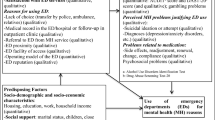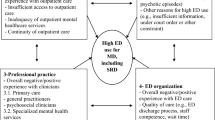Abstract
Overcrowding in emergency departments (ED) jeopardizes quality and access to health care, which represents a major issue for service delivery. This study determined predictors of frequent ED utilization among 320 patients recruited from six hospital ED in Quebec (Canada). Data collection included patient interviews and administrative databanks. A hierarchical linear regression analysis was performed using the Andersen Behavioral Model as a framework, with variables organized into predisposing, enabling, and needs factors. Results showed that needs factors were most strongly associated with ED utilization, particularly schizophrenia and personality disorders. Predisposing and enabling factors each contributed one variable to the model: past hospitalization for Mental Health (MH) reasons, and having regular care from an outpatient psychiatrist over the 12 months prior to interview at the ED, respectively. Increasing integration of MH services in networks may reduce unnecessary ED utilization and overcrowding, while providing better accessibility and care continuity for patients who visit ED for MH reasons.

Similar content being viewed by others
References
Burns TR. Contributing factors of frequent use of the emergency department: a synthesis. International Emergency Nursing. 2017;35:51–55.
Rasouli HR, Aliakbar Esfahani A, Abbasi Farajzadeh M. Challenges, consequences, and lessons for way-outs to emergencies at hospitals: a systematic review study. BMC Emergency Medicine. 2019;19(1):62.
Doupe MB, Palatnick W, Day S, et al. Frequent users of emergency departments: developing standard definitions and defining prominent risk factors. Annals of Emergency Medicine. 2012;60(1):24–32.
Larkin GL, Beautrais AL, Spirito A, Kirrane BM, Lippmann MJ, Milzman DP. Mental health and emergency medicine: a research agenda. Academic Emergency Medicine. 2009;16(11):1110–1119.
Barratt H, Rojas-Garcia A, Clarke K, et al. Epidemiology of mental health attendances at emergency departments: systematic review and meta-analysis. PLoS One. 2016;11(4):e0154449.
Clarke D, Usick R, Sanderson A, Giles-Smith L, Baker J. Emergency department staff attitudes towards mental health consumers: a literature review and thematic content analysis. International Journal of Mental Health Nursing. 2014;23(3):273–284.
Mandelberg JH, Kuhn RE, Kohn MA. Epidemiologic analysis of an urban, public emergency department's frequent users. Academic Emergency Medicine. 2000;7(6):637–646.
Hansagi H, Olsson M, Sjoberg S, Tomson Y, Goransson S. Frequent use of the hospital emergency department is indicative of high use of other health care services. Annals of Emergency Medicine. 2001;37(6):561–567.
Poremski D, Kunjithapatham G, Koh D, Lim XY, Alexander M, Lee C. Lost keys: understanding service providers' impressions of frequent visitors to psychiatric emergency services in Singapore. Psychiatric Services. 2017;68(4):390–395.
Althaus F, Paroz S, Hugli O, et al. Effectiveness of interventions targeting frequent users of emergency departments: a systematic review. Annals of Emergency Medicine. 2011;58(1):41–52 e42.
Chaput YJ, Lebel MJ. Demographic and clinical profiles of patients who make multiple visits to psychiatric emergency services. Psychiatric Services. 2007;58(3):335–341.
Sirotich F, Durbin A, Durbin J. Examining the need profiles of patients with multiple emergency department visits for mental health reasons: a cross-sectional study. Social Psychiatry and Psychiatric Epidemiology. 2016;51(5):777–786.
Fahimi J, Aurrecoechea, A., Anderson, E., Herring, A., Alter, H. Substance abuse and mental health visits among adolescents presenting to US emergency departments. Pediatric Emergency Care. 2015;31:331–338.
Pines JM, Asplin BR, Kaji AH, et al. Frequent users of emergency department services: gaps in knowledge and a proposed research agenda. Academic Emergency Medicine. 2011;18:e64–e69.
Andersen RM. Revisiting the behavioral model and access to medical care: does it matter? Journal of Health and Social Behavior. 1995;36(1):1–10.
Doran KM, Shumway M, Hoff RA, Blackstock OJ, Dilworth SE, Riley ED. Correlates of hospital use in homeless and unstably housed women: the role of physical health and pain. Women's Health Issues. 2014;24(5):535–541.
Hamilton JE, Desai PV, Hoot NR, et al. Factors associated with the likelihood of hospitalization following emergency department visits for behavioral health conditions. Academic Emergency Medicine. 2016;23(11):1257–1266.
Gasperini B, Cherubini A, Pierri F, Barbadoro P, Fedecostante M, Prospero E. Potentially preventable visits to the emergency department in older adults: results from a national survey in Italy. PLoS One. 2017;12(12):e0189925.
Huynh C, Ferland F, Blanchette-Martin N, Menard JM, Fleury MJ. Factors influencing the frequency of emergency department utilization by individuals with substance use disorders. Psychiatric Quarterly. 2016;87(4):713–728.
Richard-Lepouriel H, Weber K, Baertschi M, DiGiorgio S, Sarasin F, Canuto A. Predictors of recurrent use of psychiatric emergency services. Psychiatric Services. 2015;66(5):521–526.
Wooden MD, Air TM, Schrader GD, Wieland B, Goldney RD. Frequent attenders with mental disorders at a general hospital emergency department. Emergency Medicine Australasia. 2009;21(3):191–195.
Chang G, Weiss AP, Orav EJ, Rauch SL. Predictors of frequent emergency department use among patients with psychiatric illness. General Hospital Psychiatry. 2014;36(6):716–720.
Brunero S, Fairbrother G, Lee S, Davis M. Clinical characteristics of people with mental health problems who frequently attend an australian emergency department. Australian Health Review. 2007;31(3):462–470.
Vu F, Daeppen JB, Hugli O, et al. Screening of mental health and substance users in frequent users of a general Swiss emergency department. BMC Emergency Medicine. 2015;15:27.
Ledoux Y, Minner P. Occasional and frequent repeaters in a psychiatric emergency room. Social Psychiatry and Psychiatric Epidemiology. 2006;41(2):115–121.
Aagaard J, Aagaard A, Buus N. Predictors of frequent visits to a psychiatric emergency room: a large-scale register study combined with a small-scale interview study. International Journal of Nursing Studies. 2014;51(7):1003–1013.
Brennan JJ, Chan TC, Hsia RY, Wilson MP, Castillo EM. Emergency department utilization among frequent users with psychiatric visits. Academic Emergency Medicine. 2014;21(9):1015–1022.
Curran GM, Sullivan G, Williams K, et al. Emergency department use of persons with comorbid psychiatric and substance abuse disorders. Annals of Emergency Medicine. 2003;41(5):659–667.
Curran GM, Sullivan G, Williams K, Han X, Allee E, Kotrla KJ. The association of psychiatric comorbidity and use of the emergency department among persons with substance use disorders: an observational cohort study. BMC Emergency Medicine. 2008;8:17.
Briner D, Jäger M, Kawohl W, Baumgartner-Nietlisbach G. [Mental disorder and self-rated health among homeless people in Zurich—first epidemiological data from Switzerland]. Psychiatrische Praxis. 2017;44(6):339–347.
Jang Y, Yoon H, Chiriboga DA, Molinari V, Powers DA. Bridging the gap between common mental disorders and service use: the role of self-rated mental health among African Americans. American Journal of Geriatric Psychiatry. 2015;23(7):658–665.
Young AS, Chinman MJ, Cradock-O'Leary JA, et al. Characteristics of individuals with severe mental illness who use emergency services. American Journal of Geriatric Psychiatry. 2005;41(2):159–168.
Olsson M, Hansagi H. Repeated use of the emergency department: qualitative study of the patient's perspective. Emergency Medicine Journal. 2001;18(6):430–434.
Wise-Harris D, Pauly D, Kahan D, Tan de Bibiana J, Hwang SW, Stergiopoulos V. Hospital was the only option: experiences of frequent emergency department users in mental health. Administration and Policy in Mental Health. 2017;44(3):405–412.
Kahan D, Poremski D, Wise-Harris D, et al. Perceived case management needs and service preferences of frequent emergency department users: lessons learned in a large urban centre. PLoS One. 2016;11(12):e0168782.
Ngamini-Ngui A, Fleury MJ, Moisan J, Gregoire JP, Lesage A, Vanasse A. High users of emergency departments in Quebec among patients with both schizophrenia and a substance use disorder. Psychiatric Services. 2014;65(11):1389–1391.
Doran KM, Raven MC, Rosenheck RA. What drives frequent emergency department use in an integrated health system? National data from the veterans health administration. Annals of Emergency Medicine. 2013;62(2):151–159.
Ayangbayi T, Okunade A, Karakus M, Nianogo T. Characteristics of hospital emergency room visits for mental and substance use disorders. Psychiatric Services. 2017;68(4):408–410.
Nesper AC, Morris BA, Scher LM, Holmes JF. Effect of decreasing county mental health services on the emergency department. Annals of Emergency Medicine. 2016;67(4):525–530.
Statistics Canada. Canadian community health survey—mental health and well-being - cycle 1.2. http://www23.statcan.gc.ca/imdb-bmdi/document/3226_DLI_D1_T22_V2-eng.pdf 2003.
Bohn MJ, Babor TF, Kranzler HR. The alcohol use disorders identification test (AUDIT): validation of a screening instrument for use in medical settings. Journal of Studies on Alcohol. 1995;56(4):423–432.
Carey KB, Carey MP, Chandra PS. Psychometric evaluation of the alcohol use disorders identification test and short drug abuse screening test with psychiatric patients in India. Journal of Clinical Psychiatry. 2003;64(7):767–774.
Accietto C. La Validation d'une Version Française du Questionnaire A.U.D.I.T. "Alcohol Use Identification Test". Genève, Université de Genève; 2003.
Vandyk AD, Harrison MB, VanDenKerkhof EG, Graham ID, Ross-White A. Frequent emergency department use by individuals seeking mental healthcare: a systematic search and review. Archives of Psychiatric Nursing. 2013;27:171–178.
Bailey KP. Physical symptoms comorbid with depression and the new antidepressant duloxetine. Journal of Psychosocial Nursing Mental Health Services. 2003;41(12):13–18.
Carleton RN, Duranceau S, Freeston MH, Boelen PA, McCabe RE, Antony MM. "But it might be a heart attack": intolerance of uncertainty and panic disorder symptoms. Journal of Anxiety Disorders. 2014;28(5):463–470.
Moukaddam N, Flores A, Matorin A, Hayden N, Tucci VT. Difficult patients in the emergency department: personality disorders and beyond. Psychiatric Clinics of North America. 2017;40(3):379–395.
Pasic J, Russo J, Roy-Byrne P. High utilizers of psychiatric emergency services. Psychiatric Services. 2005;56(6):678–684.
Fleury MJ, Fortin M, Rochette L, et al. Assessing quality indicators related to mental health emergency room utilization. BMC Emergency Medicine. 2019;19(1):8.
Krieg C, Hudon C, Chouinard MC, Dufour I. Individual predictors of frequent emergency department use: a scoping review. BMC Health Services Research. 2016;16(1):594.
Douzenis A, Seretis D, Nika S, et al. Factors affecting hospital stay in psychiatric patients: the role of active comorbidity. BMC Health Services Research. 2012;12:166.
Fleury MJ, Bamvita JM, Grenier G, Schmitz N, Piat M, Tremblay J. Adequacy of help received by individuals with severe mental disorders after a major healthcare reform in quebec: predictors and changes at 5-year follow-up. Administration and Policy in Mental Health. 2016;43(5):799–812.
Slade M, Taber D, Clarke MM, et al. Best practices for the treatment of patients with mental and substance use illnesses in the emergency department. Disease-a-month. 2007;53(11–12):536–580.
Macias Konstantopoulos WL, Dreifuss JA, McDermott KA, et al. Identifying patients with problematic drug use in the emergency department: results of a multisite study. Annals of Emergency Medicine. 2014;64(5):516–525.
Parkman T, Neale J, Day E, Drummond C. Qualitative exploration of why people repeatedly attend emergency departments for alcohol-related reasons. BMC Health Services Research. 2017;17(1):140.
Institut de la statistique du Québec. Portrait statistique de la santé mentale des québécois. Résultats de l'Enquête sur la santé dans les collectivités canadiennes Santé mentale 2012; Portrait chiffré: Québec: Gouvernement du Québec, Institut de la statistique du Québec; 2015.
Fleury MJ, Grenir G, Robitaille D. Implementation of the Consultation-Liaison model in Quebec and its impact on primary care providers. Mental Health in Family Medicine. 2016; 12:228–240
Walters P, Tylee A, Golberg D. Psychiatry in Primary Care. In RM Murray, KS Kendler, P McGuffin, S Wessely, DJ Castle (eds). Essential psychiatry .UK: Cambridge University Press; 2008, pp. 479–497.
Tortajada S, Giménez-Campos MS, Villar-López J, et al. Case management for patients with complex multimorbidity: development and validation of a coordinated intervention between primary and hospital care. International Journal of Integrated Care. 2017;17(2):4.
Crane S, Collins L, Hall J, Rochester D, Patch S. Reducing utilization by uninsured frequent users of the emergency department: combining case management and drop-in group medical appointments. Journal of the American Board of Family Medicine. 2012;25(2):184–191.
Addington D, Anderson E, Kelly M, Lesage A, Summerville C. Canadian practice guidelines for comprehensive community treatment for schizophrenia and schizophrenia spectrum disorders. Canadian Journal of Psychiatry. 2017;62(9):662–672.
Moe J, Kirkland SW, Rawe E, et al. Effectiveness of interventions to decrease emergency department visits by adult frequent users: a systematic review. Academic Emergency Medicine. 2017;24(1):40–52.
Acknowledgments
We gratefully acknowledge the financial support of the Fonds de la recherche en santé du Québec (FRSQ) and l’Institut Universitaire sur les Dépendances du Québec (Addiction University Institute). We would also like to thank Judith Sabetti for editorial assistance.
Author information
Authors and Affiliations
Corresponding author
Ethics declarations
Conflict of Interest
The authors declare that they have no conflict of interest.
Additional information
Publisher’s Note
Springer Nature remains neutral with regard to jurisdictional claims in published maps and institutional affiliations.
Rights and permissions
About this article
Cite this article
Kaltsidis, G., Bamvita, JM., Grenier, G. et al. Predictors of Frequent Emergency Department Utilization for Mental Health Reasons. J Behav Health Serv Res 48, 259–273 (2021). https://doi.org/10.1007/s11414-020-09695-4
Published:
Issue Date:
DOI: https://doi.org/10.1007/s11414-020-09695-4




